#titlepage
Explore tagged Tumblr posts
Text

New chapter new me! (Lies, it's the same me that powers ahead while explaining nothing)
also, henlo <3 long time no see!!
Reminder that I'm going to start with biweekly updates from now on, just for my own sanity. I need that xD
(also also: I forgot to post this last week, so next update will be feb 26)
0 notes
Text
Day 1: Opening Ceremony
Welcome to Day 1 of the Scrap Olympics
Welcome to Day 1 of the Scrap Olympics! Are ready to get some pages/projects done? My hope is to provide you with some direction in getting those memories into a book and make progress on my own book and project. So without further ado, let the games begin! Opening or Title Page With today’s challenge, there are many ways you can look at this. It might be creating a cover to a digital…
0 notes
Text
While I'm ranting about stuff that peeves me at work, can we take a moment to say "fuck you" to whoever puts marketing information into title fields?
The box says "Title (series #)". There's even an instruction to "Enter title exactly as it is on the book then (series #) if appropriate". These are some examples of plausible titles:
Booky McBookface - title only and no series
Booky McBookface: A Book on the Shelf - title and subtitle
Booky McBookface and the Library Gang (Booky #3) - title and series #
Booky McBookface: Out Of Print (Booky #4) - title, subtitle, and series #
Here are some examples that I would NOT like to see:
Booky McBookface: CBCA Shortlisted Book 2024 - that's an award. it belongs in the awards field and maybe the description.
Booky McBookface: Now a major motion picture - that's marketing info and might be the first line of the description.
Booky McBookface: Australia's next bestseller - i'll believe that when I see the sales data, and then I'll put it in the description or (if appropriate) the awards).
Booky McBookface: the latest release by Biblio Writerson - i can figure that out from the author field and the release date.
Whoever the fuck's marketing team is messing with everyone's bibliographic data, it's time to stop. Don't do this. Be better.
#jonno rants#bookshop things#id bitch to nielsen or titlepage about it#but realistically i dont think anything would actually happen
7 notes
·
View notes
Text
Book Of Shadows Divider/Title Pages - BOS Pages

Book Of Shadows Divider/Title Pages - BOS Pages
Book Of Shadows Divider/Title Pages - BOS Pages, Organize your Book of Shadows with these beautiful dividers. Included in this packages are: 5 Packs Of Divider / Title Pages With Different Backgrounds And Designs -ASTROLOGY -CRYSTALS -HERBOLOGY -MAGIC OILS -SABBATS -POTIONS AND BREWS -ESBATS -DIVINATION -FAERIE -PRAYERS -SPELLS -CANDLES -ANGELS -GOD AND GODDESSES -RITUALS -STONES -SHADOW WORK -DIVINATION -CANDLES -RECIPES -DEITIES -FAMILIARS -TOOLS -MAGIC OIL -PRAYERS The Book of Shadows, or BOS, is used to store information you'll need in your magical tradition, whatever it may be. Many Pagans feel a BOS should be handwritten, but as technology progresses, some use their computer to store information as well. Don't let anyone tell you there's only one way to make your BOS, because you should use what works best for you. Bear in mind that a BOS is considered a sacred tool, which means it is an item of power that should be consecrated with all of your other magical tools. In many traditions, it is believed you should copy spells and rituals into your BOS by hand; this not only transfers energy to the writer, but it also helps you to memorize the contents. Make sure you write legibly enough that you’ll be able to read your notes during a ritual.
What to Include in Your Book of Shadows
When it comes to the contents of your personal BOS, there are a few sections that are nearly universally included. Book Of Shadows Divider/Title Pages - BOS Pages - Laws of Your Coven or Tradition: Believe it or not, magic has rules. While they may vary from group to group, it’s a really good idea to keep them at the front of your BOS as a reminder of what constitutes acceptable behavior and what doesn’t. If you’re part of an eclectic tradition that doesn’t have written rules, or if you’re a solitary witch, this is a good place to write down what you think are acceptable rules of magic. After all, if you don’t set yourself some guidelines, how will you know when you’ve crossed over them? This may include a variation on the Wiccan Rede, or some similar concept. - A Dedication: If you’ve been initiated into a coven, you may want to include a copy of your initiation ceremony here. However, many Wiccans dedicate themselves to a God or Goddess long before they become part of a coven. This is a good place to write out who you are dedicating yourself to, and why. This can be a lengthy essay, or it can be as simple as saying, “I, Willow, dedicate myself to the Goddess today, June 21, 2007.” - Gods and Goddesses: Depending on what pantheon or tradition you follow, you may have a single God and Goddess, or a number of them. Your BOS is a good place to keep legends and myths and even artwork concerning your Deity. If your practice is an eclectic blend of different spiritual paths, it’s a good idea to include that here. - Correspondence Tables: When it comes to spellcasting, correspondence tables are some of your most important tools. Phases of the moon, herbs, stones and crystals, colors – all have different meanings and purposes. Keeping a chart of some sort in your BOS guarantees that this information will be at the ready when you really need it. If you have access to a good almanac, it’s not a bad idea to record a years’ worth of moon phases by date in your BOS. Also, put together a section in your BOS for herbs and their uses. Ask any experienced Pagan or Wiccan about a specific herb, and chances are good that they’ll expound on not only the magical uses of the plant but also the healing properties and history of use. Herbalism is often considered the core of spellcasting because plants are an ingredient that people have used for literally thousands of years. Remember, many herbs should not be ingested, so it’s important to research thoroughly before you take anything internally. - Sabbats, Esbats, and Other Rituals: The Wheel of the Year includes eight holidays for most Wiccans and Pagans, although some traditions do not celebrate all of them. Your BOS can include rituals for each of the Sabbats. For example, for Samhain, you may wish to create a rite that honors your ancestors and celebrates the end of the harvest, while for Yule you may want to write down a celebration of the Winter Solstice. A Sabbat celebration can be as simple or complex as you wish. If you’ll be celebrating each full moon, you’ll want to include an Esbat rite in your BOS. You can use the same one each month, or create several different ones tailored to the time of year. You may also wish to include sections on how to cast a circle and Drawing Down the Moon, a rite that celebrates the invoking of the Goddess at the time of the full moon. If you’ll be doing any rites for healing, prosperity, protection, or other purposes, be sure to include them here. - Divination: If you’re learning about Tarot, scrying, astrology, or any other form of divination, keep information in here. When you experiment with new methods of divination, keep a record of what you do and the results you see in your Book of Shadows. - Sacred Texts: While it’s fun to have a bunch of new shiny books on Wicca and Paganism to read, sometimes it’s just as nice to have information that’s a little more established. If there is a certain text that appeals to you, such as The Charge of the Goddess, an old prayer in an archaic language, or a particular chant that moves you, include it in your Book of Shadows. - Magical Recipes: There’s a lot to be said for “kitchen witchery,” because for many people, the kitchen is the center of hearth and home. As you collect recipes for oils, incense, or herb blends, keep them in your BOS. You may even want to include a section of food recipes for Sabbat celebrations. - Spell Crafting: Some people prefer to keep their spells in a separate book called a grimoire, but you can also keep them in your Book of Shadows. It’s easier to keep spells organized if you divide them up by purpose: prosperity, protection, healing, etc. With each spell you include, particularly if you write your own rather than using someone else's ideas, make sure you also leave room to include information on when the working was performed and what the outcome was. Book Of Shadow Pages Shop Home Page Read the full article
#agate#agatesphere#amethyst#amethyst.citrine#astrology#auraquartzcrystals#blogs#bookofshadows#BookOfShadowsDivider/TitlePages-BOSPages#bos#cabochon#chakra#chlorite#citrine#clairvoyant#clarity#cleansing#cleansingcrystals#clearquartz#courage#crystalballs#crystalgrids#crystallove#crystalmagic#crystalreiki#crystalshop#crystalstore#crystaltarot#crystals#cutandpolished
3 notes
·
View notes
Text
This fucking close to try and attempt fanfic bookbinding
1 note
·
View note
Text
if there's one thing ive learned from my math education it's the ability to judge a textbook by it's cover:
fancy cover with actual picture, fewer than 15 years old, $300: absolute dogshit. time wasting exercises, poor exposition, that weird gloss they put on the pages probably makes it too toxic to use as kindling
title is just name of subject, referred to by author, 50 years old with like 3 editions: excellent. compact proofs, exercises good enough people refer to them by number in conversation. available for free by foraging somewhere they grow naturally
title is some shit like paul's notes, "cover" is just default latex titlepage, distributed as pdf to grad classes or by advisor: best coverage of whatever (usually niche) topic it's about in the world. crystal clear exposition. solutions to exercises available by emailing grad students working under author
7K notes
·
View notes
Text
Join COMMUNITY to HELP OUT THIS PERSON.
Martha Bradley (fl. 1740s–1755) was a British cookery book writer. Little is known about her life, except that she published the cookery book The British Housewife in 1756 and worked as a cook for over thirty years in the fashionable spa town of Bath, Somerset.
Two pages from The British Housewife: on the left, an illustration showing three cooks in a kitchen; on the right, the titlepage, with extended title, details of the contents and the publisher's details.
The frontispiece and titlepage of Bradley's 1758 work The British Housewife
Bradley's only printed work, The British Housewife was released as a 42-issue partwork between January and October 1756.[a] It was published in a two-volume book form in 1758, and is more than a thousand pages long. It is likely that Bradley was dead before the partwork was published. The book follows the French style of nouvelle cuisine, distinguishing Bradley from other female cookery book writers at the time, who focused on the British or English style of food preparation. The work is carefully organised and the recipes taken from other authors are amended, suggesting she was a knowledgeable and experienced cook, able to improve on existing dishes.
Because of the length of The British Housewife, it was not reprinted until 1996; as a result, few modern writers have written extensively on Bradley or her work.
Life
Illustration showing seven dishes to have as part of a course, including dishes with carp, lobster, hare, ducks and woodcocks
Illustrated example of a dinner in winter, as suggested by Bradley
Little is known about the life of Martha Bradley, and what there is has come from her single publication, The British Housewife. In the 1740s she worked as a professional cook in the fashionable spa town of Bath, Somerset,[1] and had over thirty years' experience in the job.[2] The publisher of The British Housewife noted that all of Bradley's papers had been stored with him; the food historian Gilly Lehmann considers this shows Bradley was dead by the time the work was published in the late 1750s. Included in the papers was a handwritten family recipe collection.[1] A reference in the work to William Hogarth's 1753 book The Analysis of Beauty indicates that at least some of the book was written after that date.[1]
Based on the recipes shown in her work, Lehmann considers it appears that Bradley had read several contemporary cookery books, including those by Mary Eales (Mrs Mary Eales's Receipts, 1718), Patrick Lamb (Royal Cookery, 1726—the third edition), Vincent La Chapelle (The Modern Cook, 1733) and Hannah Glasse (The Art of Cookery Made Plain and Easy, 1747).[1] The recipes from these have all been changed and improved from the originals, with a reduced set of ingredients and simplified instructions;[3][4] according to the food writer Alan Davidson, this showed she had been knowledgeable and able in her chosen career.[5] According to Lehmann The British Housewife was more than just a cookery book, but instead was "a complete manual for the housewife, the cook, the housekeeper, the gardener and the farrier, with monthly sections of advice and recipes which cover every aspect of domestic management in the middle of the eighteenth century".[1]
The British Housewife was first published as a partwork in 42 weekly editions,[6] possibly the first cookery book issued in this manner;[7][8] the first issue was on 10 January 1756.[9] The weekly editions comprised "four large half-sheets of printing" costing 3d.[9] The weekly editions would have finished in October that year, and would have cost 10s 6d in total.[6][b] The partworks were advertised across Britain, including Oxford,[9] Leeds,[11] Manchester[12] and Sussex.[13] In the text of the partworks Bradley would advertise the other issues, telling readers "We have in our preceding numbers given the cook so ample instruction for the roasting of all plain joints of meat ... that she cannot be at a loss in any of them".[14]
The work was published in book form in 1758; its two volumes comprised over 1,200 pages.[3][15] Some sources show differing dates. Virginia Maclean's 1981 history A Short-Title Catalogue of Household and Cookery Books Published in the English Tongue, 1701–1800 put the publication date at 1760,[16] but Arnold Oxford's 1913 work English Cookery Books to the Year 1850 listed it as c. 1770 with 752 pages.[17]
The British Housewife (1758)
Illustration showing meats prepared for cooking; meats include hare, rabbit, woodcock or snipe, pigeon, partridge and chicken
Game cuts trussed for roasting; an illustration from The British Housewife
The British Housewife, as published in 1758,[a] contains recipes for fricassees,[19] ragùs (which Bradley spelled "Ragoo"),[20] collops,[21] pilafs,[22] pasties,[23] pies (including oyster and eel),[24] fish dishes,[25] soups (which she spelled as both "soup" and "soop"), bisques,[26] desserts—including puddings,[27] jellies,[28] pancakes,[29] fritters,[30] flummeries,[31] cakes[32] syllabubs[33] and confectionery[34]—and preserved foods, including pickles and jams.[35] Bradley also included a section dedicated to distilling spirits, as well as making wine, beer and cider.[36] Bradley's recipes include most parts of the animal, including the intestines, cockscombs, knuckle, head, heart, tongue, udder, trotters, feet, ears and cheeks.[37] The book also contained a chapter on cures for common ailments, which included a recipe that used powdered earthworm to cure ague.[38]
The British Housewife showed a "sophisticated organisation", according to Davidson,[5] and Petits Propos Culinaires considers that Bradley's "scheme for the education of the cook and housewife was more thorough than any that had gone before".[7] The literary historian Henry Notaker identifies strong pedagogical form and strategy within the book. This is highlighted by Bradley when she writes: "in all studies it is the regular practice to begin with the plainest and easiest things, and from there to arise to such as are more difficult",[39] and she progressed from techniques such as roasting and boiling "and thence leading the cook to the most elegant and difficult made dishes".[39][40] The food historian Sandra Sherman sees a pedagogical form in the layout of the recipes, and notes the "deliberate, reinforcing logic [that] entails the reader's attentiveness in a process that produces results".[41] Sherman sees "a slightly disciplinary edge" in Bradley's approach in ensuring that the readers followed the instructions,[42] and reports that the structure "makes ... [the book's] advice seem consistent, accurate, and acceptable".[43] The culinary historians Anne Willan, Mark Cherniavsky and Kyri Claflin describe Bradley as "the consummate cooking teacher", and her book as "a cooking course that starts with the basics and builds in complexity".[44]
The work was divided into monthly sections and these allowed Bradley to reflect the natural pace of the seasons in line with the available supply of produce for each month. According to Sherman, it was "designed to bring out the best in available provisions, and like such texts it contains elaborate directions for putting foods by".[45] In doing so, the book "integrates food preparation with its production, that is, with gardening and raising animals", and thus provides a holistic approach to food planning and preparation.[45]
As with many of the cookery books of the period, The British Housewife has nationalistic elements.[46] Bradley's recipes strongly favour British ingredients, and there is no reference to French drinks, such as claret, Burgundy or champagne; instead, she calls for home-made turnip or raisin wines, and favours port ten times more than any other wine.[46] Included in the ingredients described as being traditionally English were those imported from the British colonies of Asia, Africa and the Americas.[47][48] Bradley describes how cayenne pepper is "imported ... from the negroes of our plantations. The fruit is common in Africa, they have been accustomed to eat it there, shewed our people the way in America, and they have taught us". The Anglicist Wendy Wall notes that this demonstrated the connection between the British cook and the slave system.[49]
Despite the nationalistic approach, there are strong French influences throughout the book. This includes the French style of a circular dining table, with the symmetrical placement of dishes and plates for a diner's ease;[46] Bradley was one of the very few female cookery book writers in eighteenth-century England to write in support of the French style of nouvelle cuisine.[50][c] Bradley described her aim for the book thus, "Our cook ... will be able to show that an English girl, properly instructed at first, can equal the best French gentleman in everything but expense."[53] Economy and practicality are shown throughout her approach, according to the food historian Ivan Day; he classes Bradley alongside Hannah Glasse and Elizabeth Raffald in this respect. All three showed an economical aspect to their recipes, unlike the male cookery book writers of the time who, Day observes, "liked to show off with a flamboyant style of cooking".[54]
Although Bradley gave support for some aspects of French dining, she was also happy to criticise the French's approach to certain dishes, including their habit of using ingredients that have the effect of hiding the flavour of some elements of the dish.[55] At the end of a recipe for roast capon with herbs, she advises that adding a "raggoo" (a sauce[d]) will make it more fashionable, but not improve it:[57]
The French, who never know when to stop, serve up a capon done in this manner with a rich raggoo about it, but this is confusion, and the taste of one thing destroys that of another. They who would be at the top of the French taste may serve it in this manner, but with gravy it is a very delicate and fine dish, and no way extravagant in the expense.[58]
The French were not the only nation to face criticism; one recipe for roast pork discusses Germanic animal husbandry practices: "The Germans whip him to death, but they deserve the same fate for their cruelty; there is no occasion for such barbarity to make a dainty dish".[59]
The British Housewife contains several illustrations throughout. The frontispiece of the book shows three women working in a kitchen above the motto "Behold you fair, united in this book. The frugal housewife and the experienced cook."[60][61] Other illustrations comprise examples of how to truss cuts of game,[62] samples of menus to have at different times of the year[63] and how to lay food on a table in a pleasing manner.[64] According to Bradley, the illustrations were more than just for decoration; they served the purpose that "even those who cannot read will be able to instruct themselves".[65] When discussing the placement of dishes on the table, she writes: "To please the palate is one design of this branch of study, and to please the eye is another".[66]
The British Housewife has been used as a source in several works of social and food history, and Bradley's recipes still appear in modern cookery books.[e] The book was used in Colonial America[73] and Ireland.[74] The scale of the book—at over 1,000 pages—ensured the work was not reprinted until 1996, which meant it fell out of public knowledge and few modern writers have written extensively on Bradley or her work.[7] Davidson, who considers The British Housewife "the most interesting of the 18th century English cookery books",[5] thinks "one has the feeling in reading ... [Bradley's] work that here is a real person, communicating effectively with us across the centuries".[5] The Anglicist Robert James Merrett considers the work "the most encyclopedic and personally engaged cookbook of the century".[75] Lehmann opines that Bradley's personal involvement in developing the recipes stands out in the book.[1] Writing in the Oxford Dictionary of National Biography, she considers that:
Bradley is one of the most important cookery writers of the eighteenth century, not only because her book is one of the most comprehensive of its kind but also because she discusses the merits and difficulties of the dishes, gives information on European as well as English cookery, and tells the reader what is old-fashioned and what is up to date. In an age when most cookery books were simply compilations Mrs Bradley's book stands out for the author's personal involvement in her recipes.[1]
#free gaza#free palestine#gaza#palestinian genocide#gaza strip#gaza genocide#help gaza#palestine gfm#save palestine#gfm#help palestine#please help
269 notes
·
View notes
Text


Peacemaker by @astolat
Megatron just stared at him through the cell door with a strange expression and didn't say anything. "Well?" Optimus said, half furious and desperate. "Will you promise not to hurt any Autobots escaping if I let you out?"
Fandom: Transformers Animated (2007)
Relationships: Megatron/Optimus Prime
Rating: Explicit
Basically anything by astolat is automatically a certified banger and her Transformers fics are no exception. Yapping about making this thang under the read more.
Yet another horizontal letter quarto. This format just feels nice to hold and in my opinion makes binds stand out.


I feel in love with this rainbow design card stock I got from a pack at Dollar General and knew I wanted to use it for this fanfic. I loooooove how copper looks with rainbow patterns and designs so I knew I had to make the title copper. I don't have any copper foil or vinyl in my stash, but I do have copper paint, so I tried my hand at using a stencil and acrylic paint for the first time. It was very nerve-wrecking to do, but turned out looking very nice. The bookcloth used was black Allure from Hollander's.
I also did a new endband style. It's the bead on spine style. It's apparently used today as a conservation endband. It's good if you just want a simple one colored endband that has a bit more oomph than a glue on.


The endpapers are black cardstock.
For the typesetting I used Copperplate Gothic Bold for the Drop cap and the titlepage. The body text is Georgia.
57 notes
·
View notes
Text
Shakespeare Weekend
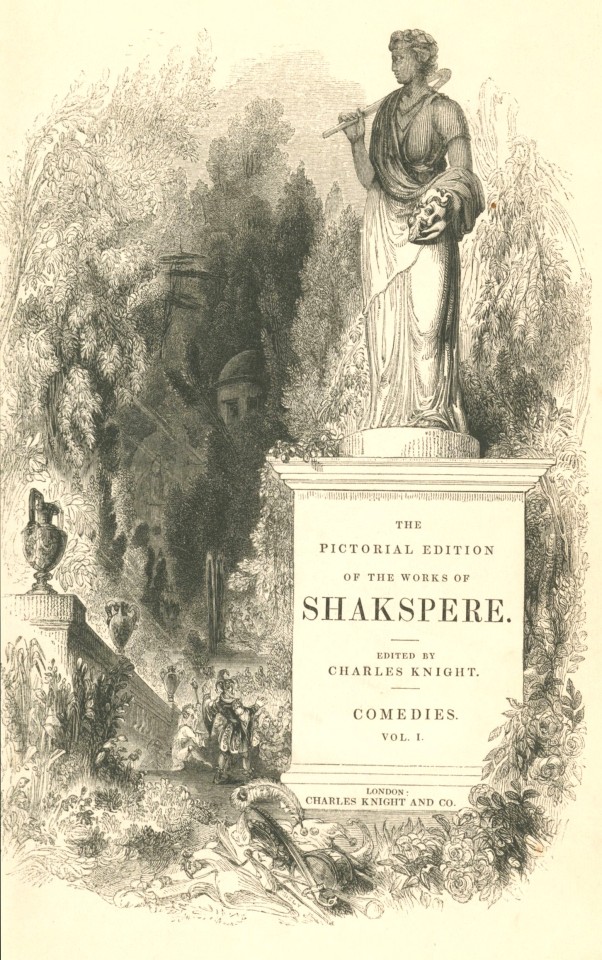

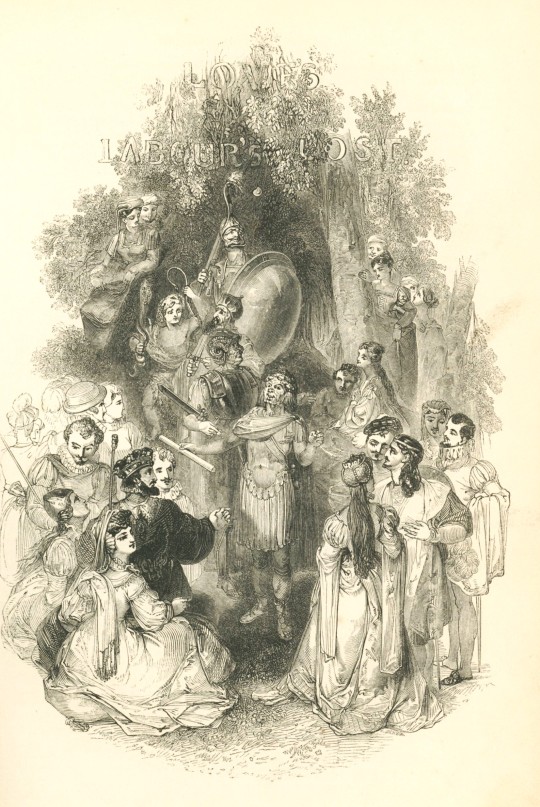
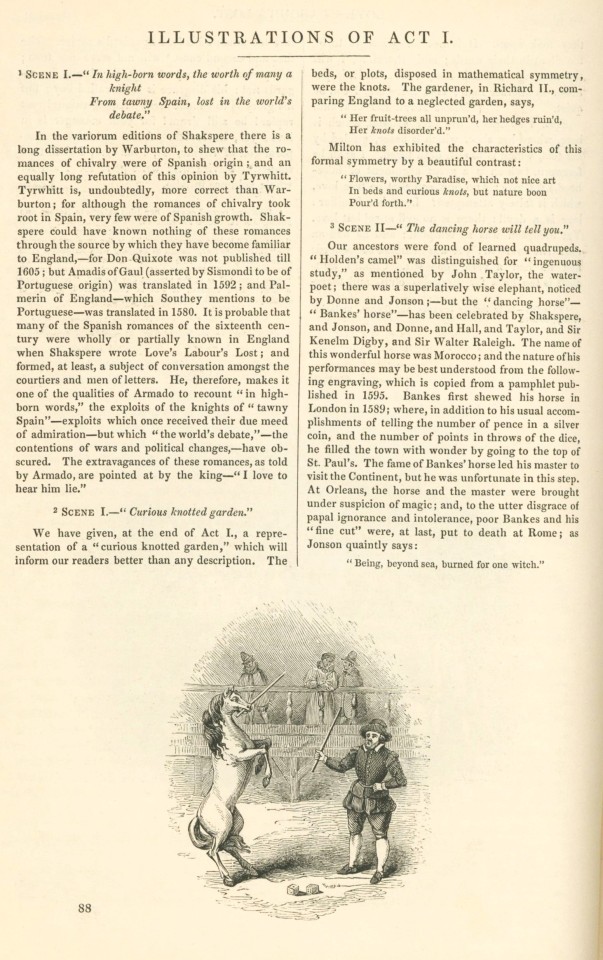
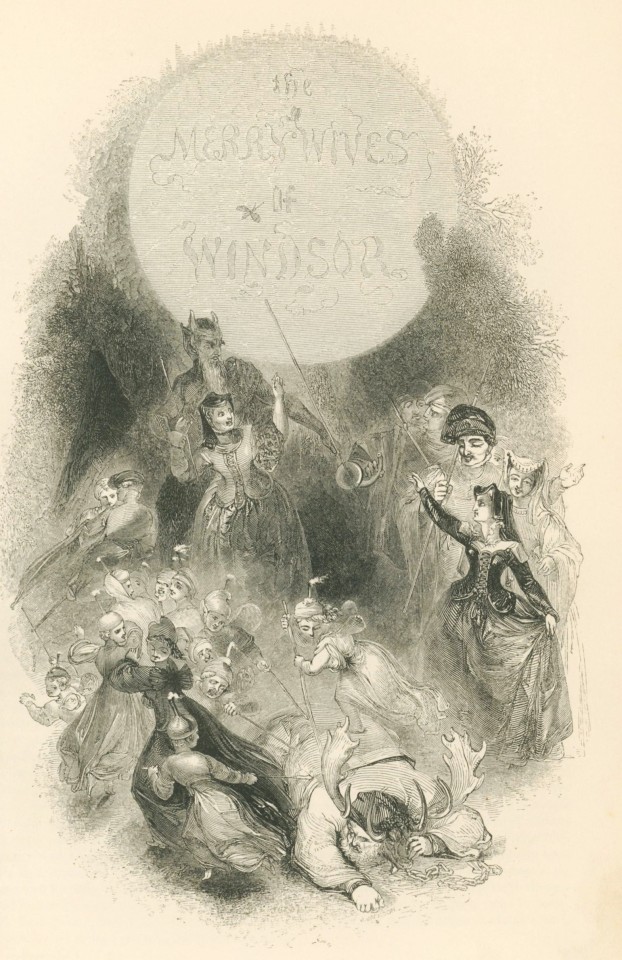
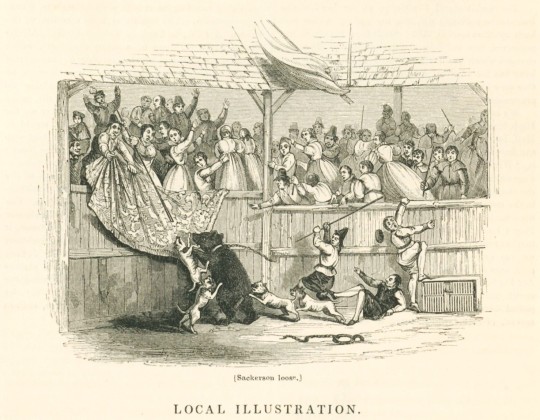
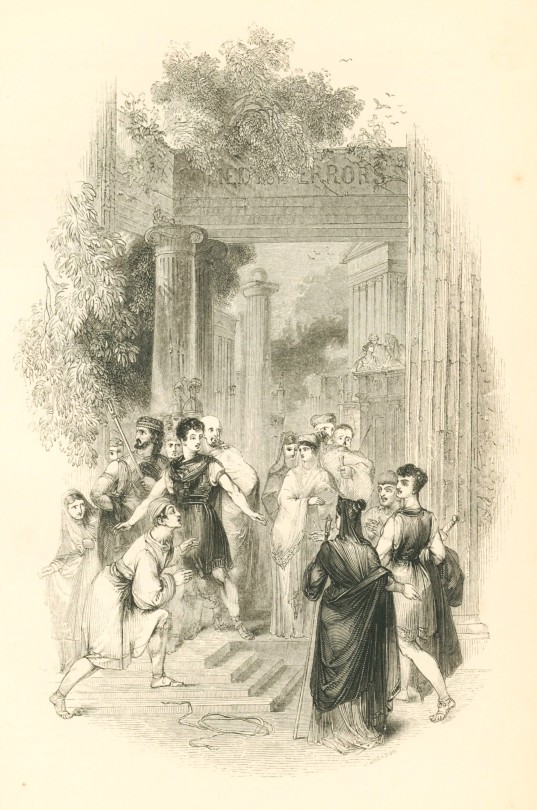

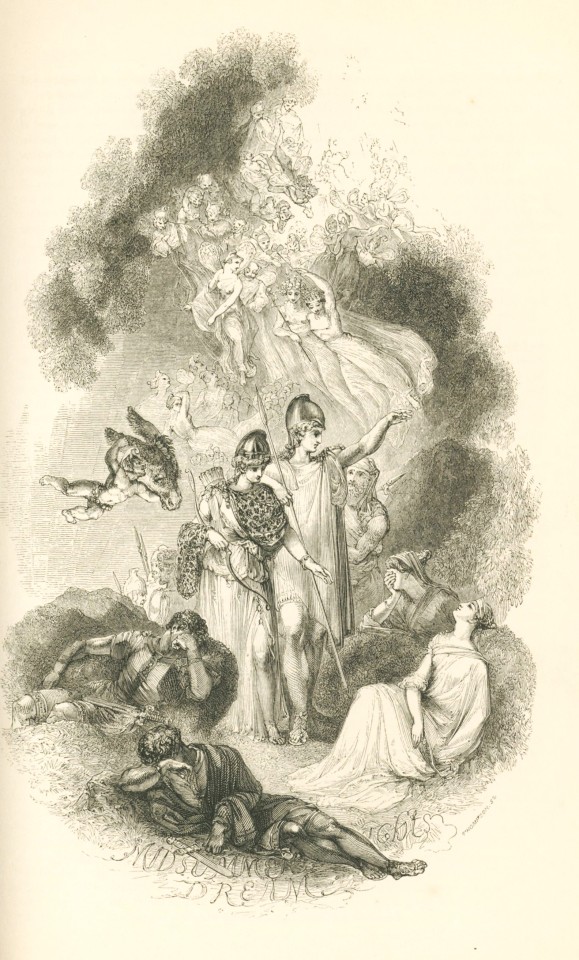
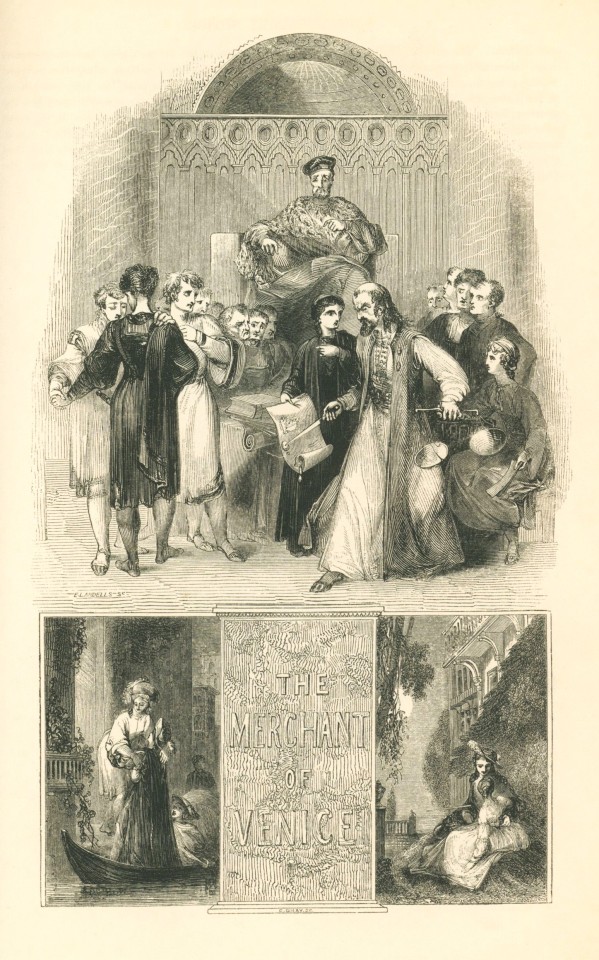
The Pictorial Edition of the Works of Shakspere edited and published by Charles Knight (1797-1873) out of London in 1839 was originally issued in fifty-six monthly parts before being bound in an eight-volume set. Like earlier Shakespeare editors, Knight felt all previous editions of Shakespeare collections had been compiled by men who “had corrupted his text, and had never rightly appreciated his consummate art.” As an experienced publisher of encyclopedias and miscellanies, he set out to “humbly” correct their errors with an ambitiously illustrated collection.
The wood engravings place Shakespeare’s characters and events within a historical context opposed to a theatrical one and are elucidated in subsidiary segments interspersed throughout the plays’ acts. Volume One of Knight’s collection includes Two Gentlemen of Verona, Love’s Labour’s Lost, The Merry Wives of Windsor, The Comedy of Errors, Taming of the Shrew, and A Midsummer Night’s Dream. Most illustrations within the collection are unsigned, but British wood engravers John Jackson (1801-1848) and William Harvey (1796-1866) along with British painter G.F. Sargent are featured prominently among the titlepage and larger illustrations.
View more Shakespeare Weekend posts.
-Jenna, Special Collections Graduate Intern
#Shakespeare weekend#william shakespeare#the pictorial edition of the works of shakspere#charles knight#wood engravings#john jackson#william harvey#g.f. sargent
32 notes
·
View notes
Text
Eye of the tigress
What ho! Bertie Wooster sent a letter and now we know that Heloise Pringle, the woman who looks a lot like Honoria Glossop is her cousin. HER COUSIN!
Even at the moment, something about that look had struck me as oddly familiar, and now I suddenly saw why. It had been the identical look which I had observed in the eye of Honoria Glossop in the days immediately preceding our engagement—the look of a tigress that has marked down its prey.
Another smart and strong woman choose Bertie Sippy has her prey. Why are this kind of women so attracted to this kind of man?
“I mean to say, I know perfectly well that I’ve got, roughly speaking, half the amount of brain a normal bloke ought to possess. And when a girl comes along who has about twice the regular allowance she too often makes a beeline for me with the love-light in her eyes. I don’t know how to account for it, but it is so.” “It may be Nature’s provision for maintaining the balance of the species, sir.”

It took some time to Bertie to recognise the signals of attraction from the tigress Heloise, but something he learnt from his engagement to Honoria and now he's ready to save his and Sippy's arses. Time to ask for Jeeves' help!

“Do you know Bertie Wooster?” And then I saw that my name was scrawled right across the titlepage, and my heart did three back somersaults. “Oh—er—well—that is to say—well, slightly.” “He must be a perfect horror. I’m surprised that you can make a friend of him. Apart from anything else, the man is practically an imbecile. He was engaged to my cousin Honoria at one time, and it was broken off because he was next door to insane. You should hear my Uncle Roderick talk about him.”
Would his fame help him? I'm sure not. And having Sir Roderick as the one who discovered the true behing Bertie is the cherry on top of this story. Thanks, Jeeves for the suggestion of running away. The truth will set you free!
“Well, he seemed depressed, don’t you know, and rightly or wrongly I thought it might cheer him up if he stepped across the street and collared a policeman’s helmet. He thought it a good idea, too, so he started doing it, and the man made a fuss, and Oliver sloshed him.” “Sloshed him?” “Biffed him—smote him a blow—in the stomach.” “My nephew Oliver hit a policeman in the stomach?” “Absolutely in the stomach. And next morning the beak sent him to the Bastille for thirty days without the option.”
Mr. Wooster, I really admire the strength you had to say this.
“You aren’t annoyed?” I said. “Annoyed?” She chuckled happily. “I’ve never heard such a splendid thing in my life.”
So this aunt is slightly acab and Jeeves used this information on Bertie and Sippy's favour... That's an amazing idea!
Poor Bertie, he was almost captured (and kissed!) by Heloise Pringle, he has another encounter with Sir Roderick and had to run away. At least Miss Sipperley enjoyed the adventure of his nephew Oliver and Bertie had quality time with a cat.

#letters regarding jeeves#jeeves and wooster#bertie wooster#reginald jeeves#heloise pringle#honoria glossop#bertram wooster#letters in the underground
12 notes
·
View notes
Text
THE MOVIES (RADON)
• but the shadow
• and the order
• or a force
• to the titlepage
• to a rose
• and the others
• to the phases
• and the candlestick
• and the mind
• But the notes
• and the swallows
• and the pox
0 notes
Text
speaking of discworld my brother sent me a picture of the titlepage of guards! guards! (wich i helped him pick out) a few days ago, so now im just sort of anxiously waiting to find out if i picked the right book for him to start with and if ive managed to convert him >:3
0 notes
Text
Martha Bradley (fl. 1740s–1755) was a British cookery book writer. Little is known about her life, except that she published the cookery book The British Housewife in 1756 and worked as a cook for over thirty years in the fashionable spa town of Bath, Somerset.
Two pages from The British Housewife: on the left, an illustration showing three cooks in a kitchen; on the right, the titlepage, with extended title, details of the contents and the publisher's details.
The frontispiece and titlepage of Bradley's 1758 work The British Housewife
Bradley's only printed work, The British Housewife was released as a 42-issue partwork between January and October 1756.[a] It was published in a two-volume book form in 1758, and is more than a thousand pages long. It is likely that Bradley was dead before the partwork was published. The book follows the French style of nouvelle cuisine, distinguishing Bradley from other female cookery book writers at the time, who focused on the British or English style of food preparation. The work is carefully organised and the recipes taken from other authors are amended, suggesting she was a knowledgeable and experienced cook, able to improve on existing dishes.
Because of the length of The British Housewife, it was not reprinted until 1996; as a result, few modern writers have written extensively on Bradley or her work.
Life
Illustration showing seven dishes to have as part of a course, including dishes with carp, lobster, hare, ducks and woodcocks
Illustrated example of a dinner in winter, as suggested by Bradley
Little is known about the life of Martha Bradley, and what there is has come from her single publication, The British Housewife. In the 1740s she worked as a professional cook in the fashionable spa town of Bath, Somerset,[1] and had over thirty years' experience in the job.[2] The publisher of The British Housewife noted that all of Bradley's papers had been stored with him; the food historian Gilly Lehmann considers this shows Bradley was dead by the time the work was published in the late 1750s. Included in the papers was a handwritten family recipe collection.[1] A reference in the work to William Hogarth's 1753 book The Analysis of Beauty indicates that at least some of the book was written after that date.[1]
Based on the recipes shown in her work, Lehmann considers it appears that Bradley had read several contemporary cookery books, including those by Mary Eales (Mrs Mary Eales's Receipts, 1718), Patrick Lamb (Royal Cookery, 1726—the third edition), Vincent La Chapelle (The Modern Cook, 1733) and Hannah Glasse (The Art of Cookery Made Plain and Easy, 1747).[1] The recipes from these have all been changed and improved from the originals, with a reduced set of ingredients and simplified instructions;[3][4] according to the food writer Alan Davidson, this showed she had been knowledgeable and able in her chosen career.[5] According to Lehmann The British Housewife was more than just a cookery book, but instead was "a complete manual for the housewife, the cook, the housekeeper, the gardener and the farrier, with monthly sections of advice and recipes which cover every aspect of domestic management in the middle of the eighteenth century".[1]
The British Housewife was first published as a partwork in 42 weekly editions,[6] possibly the first cookery book issued in this manner;[7][8] the first issue was on 10 January 1756.[9] The weekly editions comprised "four large half-sheets of printing" costing 3d.[9] The weekly editions would have finished in October that year, and would have cost 10s 6d in total.[6][b] The partworks were advertised across Britain, including Oxford,[9] Leeds,[11] Manchester[12] and Sussex.[13] In the text of the partworks Bradley would advertise the other issues, telling readers "We have in our preceding numbers given the cook so ample instruction for the roasting of all plain joints of meat ... that she cannot be at a loss in any of them".[14]
The work was published in book form in 1758; its two volumes comprised over 1,200 pages.[3][15] Some sources show differing dates. Virginia Maclean's 1981 history A Short-Title Catalogue of Household and Cookery Books Published in the English Tongue, 1701–1800 put the publication date at 1760,[16] but Arnold Oxford's 1913 work English Cookery Books to the Year 1850 listed it as c. 1770 with 752 pages.[17]
The British Housewife (1758)
Illustration showing meats prepared for cooking; meats include hare, rabbit, woodcock or snipe, pigeon, partridge and chicken
Game cuts trussed for roasting; an illustration from The British Housewife
The British Housewife, as published in 1758,[a] contains recipes for fricassees,[19] ragùs (which Bradley spelled "Ragoo"),[20] collops,[21] pilafs,[22] pasties,[23] pies (including oyster and eel),[24] fish dishes,[25] soups (which she spelled as both "soup" and "soop"), bisques,[26] desserts—including puddings,[27] jellies,[28] pancakes,[29] fritters,[30] flummeries,[31] cakes[32] syllabubs[33] and confectionery[34]—and preserved foods, including pickles and jams.[35] Bradley also included a section dedicated to distilling spirits, as well as making wine, beer and cider.[36] Bradley's recipes include most parts of the animal, including the intestines, cockscombs, knuckle, head, heart, tongue, udder, trotters, feet, ears and cheeks.[37] The book also contained a chapter on cures for common ailments, which included a recipe that used powdered earthworm to cure ague.[38]
The British Housewife showed a "sophisticated organisation", according to Davidson,[5] and Petits Propos Culinaires considers that Bradley's "scheme for the education of the cook and housewife was more thorough than any that had gone before".[7] The literary historian Henry Notaker identifies strong pedagogical form and strategy within the book. This is highlighted by Bradley when she writes: "in all studies it is the regular practice to begin with the plainest and easiest things, and from there to arise to such as are more difficult",[39] and she progressed from techniques such as roasting and boiling "and thence leading the cook to the most elegant and difficult made dishes".[39][40] The food historian Sandra Sherman sees a pedagogical form in the layout of the recipes, and notes the "deliberate, reinforcing logic [that] entails the reader's attentiveness in a process that produces results".[41] Sherman sees "a slightly disciplinary edge" in Bradley's approach in ensuring that the readers followed the instructions,[42] and reports that the structure "makes ... [the book's] advice seem consistent, accurate, and acceptable".[43] The culinary historians Anne Willan, Mark Cherniavsky and Kyri Claflin describe Bradley as "the consummate cooking teacher", and her book as "a cooking course that starts with the basics and builds in complexity".[44]
The work was divided into monthly sections and these allowed Bradley to reflect the natural pace of the seasons in line with the available supply of produce for each month. According to Sherman, it was "designed to bring out the best in available provisions, and like such texts it contains elaborate directions for putting foods by".[45] In doing so, the book "integrates food preparation with its production, that is, with gardening and raising animals", and thus provides a holistic approach to food planning and preparation.[45]
As with many of the cookery books of the period, The British Housewife has nationalistic elements.[46] Bradley's recipes strongly favour British ingredients, and there is no reference to French drinks, such as claret, Burgundy or champagne; instead, she calls for home-made turnip or raisin wines, and favours port ten times more than any other wine.[46] Included in the ingredients described as being traditionally English were those imported from the British colonies of Asia, Africa and the Americas.[47][48] Bradley describes how cayenne pepper is "imported ... from the negroes of our plantations. The fruit is common in Africa, they have been accustomed to eat it there, shewed our people the way in America, and they have taught us". The Anglicist Wendy Wall notes that this demonstrated the connection between the British cook and the slave system.[49]
Despite the nationalistic approach, there are strong French influences throughout the book. This includes the French style of a circular dining table, with the symmetrical placement of dishes and plates for a diner's ease;[46] Bradley was one of the very few female cookery book writers in eighteenth-century England to write in support of the French style of nouvelle cuisine.[50][c] Bradley described her aim for the book thus, "Our cook ... will be able to show that an English girl, properly instructed at first, can equal the best French gentleman in everything but expense."[53] Economy and practicality are shown throughout her approach, according to the food historian Ivan Day; he classes Bradley alongside Hannah Glasse and Elizabeth Raffald in this respect. All three showed an economical aspect to their recipes, unlike the male cookery book writers of the time who, Day observes, "liked to show off with a flamboyant style of cooking".[54]
Although Bradley gave support for some aspects of French dining, she was also happy to criticise the French's approach to certain dishes, including their habit of using ingredients that have the effect of hiding the flavour of some elements of the dish.[55] At the end of a recipe for roast capon with herbs, she advises that adding a "raggoo" (a sauce[d]) will make it more fashionable, but not improve it:[57]
The French, who never know when to stop, serve up a capon done in this manner with a rich raggoo about it, but this is confusion, and the taste of one thing destroys that of another. They who would be at the top of the French taste may serve it in this manner, but with gravy it is a very delicate and fine dish, and no way extravagant in the expense.[58]
The French were not the only nation to face criticism; one recipe for roast pork discusses Germanic animal husbandry practices: "The Germans whip him to death, but they deserve the same fate for their cruelty; there is no occasion for such barbarity to make a dainty dish".[59]
The British Housewife contains several illustrations throughout. The frontispiece of the book shows three women working in a kitchen above the motto "Behold you fair, united in this book. The frugal housewife and the experienced cook."[60][61] Other illustrations comprise examples of how to truss cuts of game,[62] samples of menus to have at different times of the year[63] and how to lay food on a table in a pleasing manner.[64] According to Bradley, the illustrations were more than just for decoration; they served the purpose that "even those who cannot read will be able to instruct themselves".[65] When discussing the placement of dishes on the table, she writes: "To please the palate is one design of this branch of study, and to please the eye is another".[66]
The British Housewife has been used as a source in several works of social and food history, and Bradley's recipes still appear in modern cookery books.[e] The book was used in Colonial America[73] and Ireland.[74] The scale of the book—at over 1,000 pages—ensured the work was not reprinted until 1996, which meant it fell out of public knowledge and few modern writers have written extensively on Bradley or her work.[7] Davidson, who considers The British Housewife "the most interesting of the 18th century English cookery books",[5] thinks "one has the feeling in reading ... [Bradley's] work that here is a real person, communicating effectively with us across the centuries".[5] The Anglicist Robert James Merrett considers the work "the most encyclopedic and personally engaged cookbook of the century".[75] Lehmann opines that Bradley's personal involvement in developing the recipes stands out in the book.[1] Writing in the Oxford Dictionary of National Biography, she considers that:
Bradley is one of the most important cookery writers of the eighteenth century, not only because her book is one of the most comprehensive of its kind but also because she discusses the merits and difficulties of the dishes, gives information on European as well as English cookery, and tells the reader what is old-fashioned and what is up to date. In an age when most cookery books were simply compilations Mrs Bradley's book stands out for the author's personal involvement in her recipes.[1]
After returning to northern Gaza, we have no home, no water, no electricity, and the transportation is difficult. Life is hard, and we are facing many challenges like these.
I would like to express my deepest gratitude to everyone who has supported and contributed to me and my family during this time.
My friends remember every donation, no matter how small, makes a significant difference and holds great value in helping us to improve our lives during these challenging times.
Thank you very much for everything you have done for us.
#free gaza#free palestine#gaza genocide#gazaunderattack#high support needs#gaza strip#i stand with palestine#save palestine#basic needs#gazaunderfire#gaza under attack#stand with gaza#gaza relief#war on gaza#gaza donation#palestine donation#donate when you can#please consider donating#donate if you can#please donate#donate#donations#gaza under siege#gfm#gofundme#go fund gaza#gaza gofundme#go fund them#fypツ#freepalastine🇵🇸
4K notes
·
View notes
Text
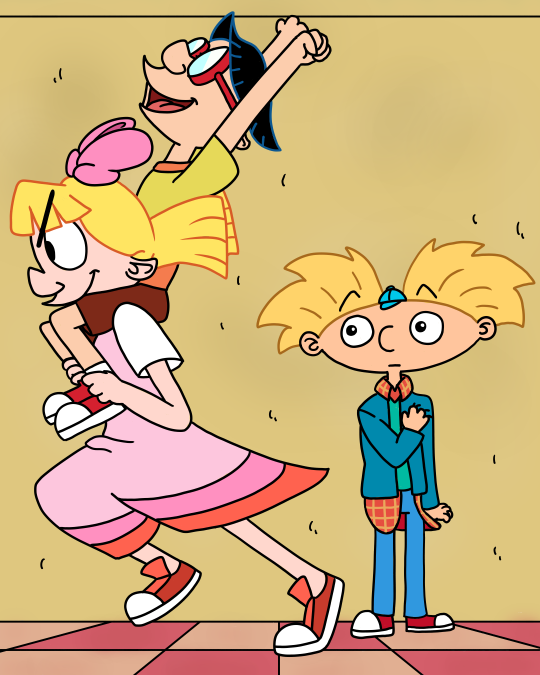
Day 8 - Creator's Choice!!
I admit, I had a heck of a time choosing what I wanted the last picture to be. I'm not the best at coming up with things on the fly sometimes, but I thought that I should finally announce properly that I'm working on a fanfic based off of this prompt I got off tumblr with a title picture I decided to finally draw! (Which, funnily enough, is my working title. Seriously: "Hey Arnold! Fanfic From This Prompt I Got Off Of Tumblr" is the first thing in my doc file.)
Essentially, it's an AU where Helga and Curly become closer friends and all the hijinks that ensue with that. They do NOT become a couple, but they do help bring out the best in each other and help the other with the affections of their crushes, Rhonda and Arnold (who are now noticing Curly and Helga because the two have pranked [most of] PS118 into thinking they're dating).
I don't have many chapters pre-written, I'm unsure where to publish them, and I don't even have a title. But I'm having so much fun writing about these goobers that I feel as though I should publish it on one of the many sites soon... As soon as I have a title! If you have an idea for a title, comment an idea and maybe I'll use it! (And thank you, of course.)
But with that, I have successfully made it through an entire Shortaki Week! On time! It's been an absolutely amazing ride and I enjoyed every moment! Thank you to my new fans! Thank you for all your lovely comments! Thank you other artists who participated! Thank you to Craig who was so awesome to 'like' two of my pictures (at time of writing)! Thank YOU reading this! I had an absolute blast making all this art and I hope to make a lot more soon! Thank you all again!
#shortaki#shortakiweek#shortakiweek2023#dayeight#creatorschoice#fanfictiontitlepage#titlepage#PS118#heyarnoldfanart#heyarnold#arnoldshortman#helgapataki#thaddeusgammelthorpe#curly#wip#thegoodenchantress22
44 notes
·
View notes
Text
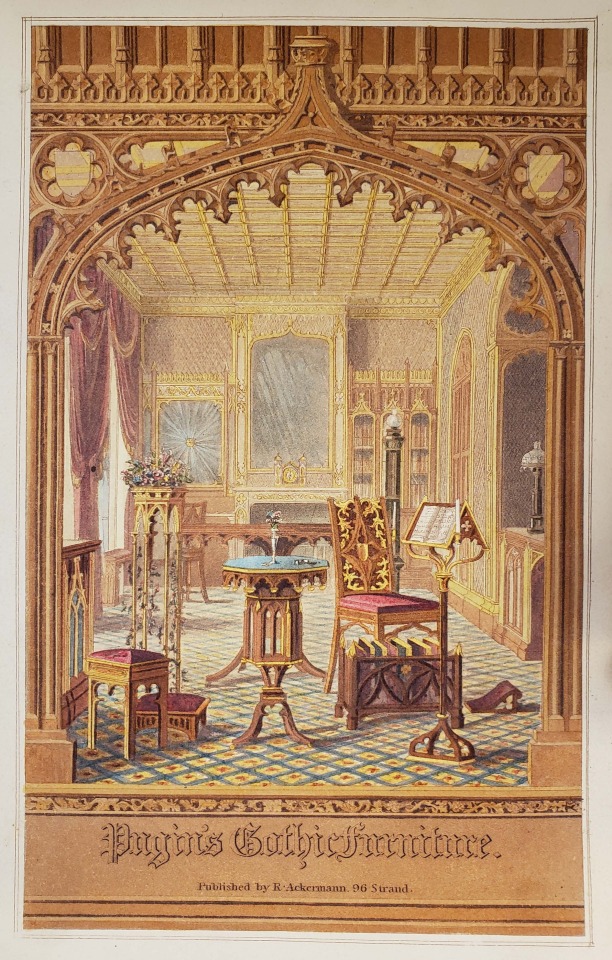
From: Pugin, Augustus, 1762-1832. Gothic furniture. London : R. Ackermann, 1827 or 1828
#titlepage#titlepageillustration#gothic#gothicstyle#gothicfurniture#gothicroom#ornate#augustuspugin#titlepagetuesday#rarebooks#specialcollections#libraryofva
96 notes
·
View notes
Photo
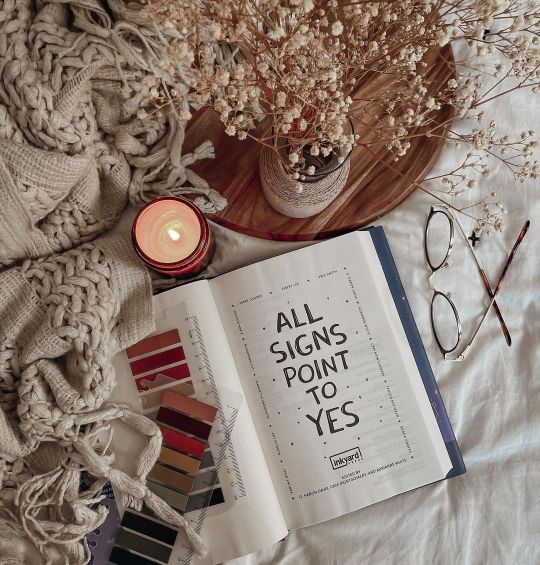
💬 What are you currently reading? 🤎📖 A literal star-studded anthology that delivers a love story for every star sign straight from the hearts of thirteen multicultural YA authors. A haunted Aquarius finds love behind the veil. An ambitious Aries will do anything to stay in the spotlight. A foodie Taurus discovers the best eats in town (with a side of romance). A witchy Cancer stumbles into a curious meet-cute. Whether it’s romantic, platonic, familial, or something else you can’t quite define, love is the thing that connects us. All Signs Point to Yes will take you on a journey from your own backyard to the world beyond the living as it settles us among the stars for thirteen stories of love and life. These stories will touch your heart, speak to your soul, and have you reaching for your horoscope forevermore. Thank you to @inkyardpress for sending me a copy of the book. . . . h a s h t a g s : #AllSigsPointtoYes #inkyardpress #storygramtours #titlepage #openbook #booknerdigans #bookworm #bookish #bookishthings #readersofig #booksofig #bookworld #booklovers #bookhoarder #totalbooknerd #totalbooknerd https://www.instagram.com/p/CeKJUobu9DV/?igshid=NGJjMDIxMWI=
#allsigspointtoyes#inkyardpress#storygramtours#titlepage#openbook#booknerdigans#bookworm#bookish#bookishthings#readersofig#booksofig#bookworld#booklovers#bookhoarder#totalbooknerd
36 notes
·
View notes